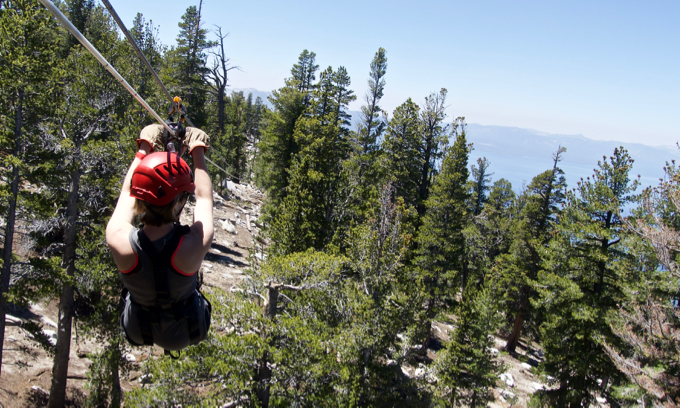Plenty to do without snow on top of Heavenly

Jessie Marchesseau flies along one of the ziplines at Heavenly with Lake Tahoe in the distance. Photo/Kathryn Reed
By Kathryn Reed
“Zip on” – it’s a phrase being echoed through the trees at Heavenly Mountain Resort.
At speeds of 35 mph it’s almost like Lake Tahoe is a blur of blue flying by. A series of seven ziplines and two sky bridges on the Skyway zipline tour are hidden in the woods; starting behind the Tamarack Lodge and finishing just below the midway station of the gondola. The longest being 950 feet.
On this particular day four members of the Lake Tahoe News team had an opportunity to tryout whatever we wanted at Epic Discovery, the summer playground Heavenly has created at the top of the gondola.
None of us had been on the Skyway; in fact, this was a first for Jessie and Terra to experience any of the summer amenities. For Sue it was her inaugural time on a zipline.
There is no arguing this is an incredibly scenic and unique way to experience the Tahoe forest.

Sue Wood on belay as she descends the last tree platform. Photo/Kathryn Reed
It takes about three hours to complete the tour. This does not include getting the gear on and off. It definitely takes a certain amount of fitness to even walk to the starting point with harness et al, and then to be able to pull yourself in on the line.
We took a little longer than usual because one person had to leave early and therefore be belayed from one of the tree platforms, and another didn’t stop correctly so she had to be pulled in by one of the guides.
A big shout out to Mikey and Jackson who were exceptional guides. Their instruction, patience and encouragement were outstanding.
After a bite to eat we took a spin down the tubing hill. While at the bottom it doesn’t look like much, it goes faster than you expect. Ask the attendants at the top for a spin to make it even more fun.

One of two bridges to cross along the Skyway zipline tour. Photo/Kathryn Reed
While Jessie and I were up for doing more, we didn’t want to take the time it would to complete one of the ropes courses. We figured if there were a next time, we’d do the ropes course first and then one of the zipline courses. However, there is a limited number of people allowed on many of the apparatuses and some require reservations, so timing could be tricky.
Even though the Skyway had views of the lake, the Silver Rush zipline actually seems better because it has fewer (five ziplines, longest 1,510 feet). The seven seemed like too many, with a bit of redundancy.
Unfortunately, my favorite element of summer fun, the coaster, was not open that day, though it is now. It was closed all last summer because it had to be completely rebuilt after Mother Nature ripped it apart in the winter of 2016-17.

Tubing is one of the activities at the top of the gondola. Photo/Kathryn Reed
Before going make sure everything you want to do is operating. Just like in winter when Heavenly charges full price when a fraction of the mountain is open, in summer it’s full price no matter the amenities that are functioning.
The three of us at the end assessed whether we would have paid the $199 each (fourth person is free) for what we did. No – was the answer. That fee included one of the zipline tours, three ropes courses, coaster, tubing, and rock climbing wall. Extra are the two single ziplines and the expedition tours. Yes, it was our choice not to do more. Maybe had we paid we would have found the gumption to go on one of the ropes courses. We called it day, still wondering if we would recommend all of this to our out of town guests who would be arriving with disposable income for something like this.

